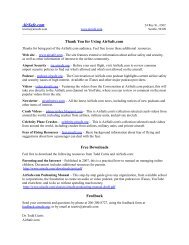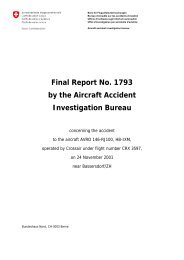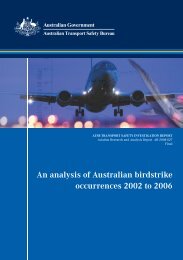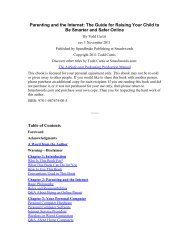AAIB Investigation Updates (PDF) - Airline Safety and Security ...
AAIB Investigation Updates (PDF) - Airline Safety and Security ...
AAIB Investigation Updates (PDF) - Airline Safety and Security ...
Create successful ePaper yourself
Turn your PDF publications into a flip-book with our unique Google optimized e-Paper software.
<strong>AAIB</strong> Special Bulletin: 1/2008 G-YMMM EW/C2008/01/01<br />
Examination <strong>and</strong> tests of the wiring identified that, in the<br />
case of the right engine, the valve CLOSE wire from the run/<br />
cut-off relay was still continuous. This could have allowed<br />
the valve to operate had the fuel switch been operated<br />
before the fire h<strong>and</strong>le.<br />
Boeing had issued a Service Bulletin (SB 777-28-0025)<br />
which advised the splicing together of the wires for the fuel<br />
control switches <strong>and</strong> the fire h<strong>and</strong>les to avoid the need to<br />
sequence their operation. An FAA airworthiness directive<br />
requires this SB to be completed by July 2010. This had<br />
not yet been incorporated on G-YMMM; however, had it<br />
been incorporated, the right spar valve should have closed<br />
when the fuel control switch was operated.<br />
The evacuation checklist for the Boeing 777, issued by<br />
Boeing, shows operation of the fuel control switches<br />
to cut-off prior to operation of the fire h<strong>and</strong>les. This<br />
sequence allows for both CLOSE paths to the spar valve<br />
to be exploited <strong>and</strong> increases the likelihood that the spar<br />
valves close before electrical power to the spar valves is<br />
isolated. However, if the fire h<strong>and</strong>le is operated first,<br />
then only a single path is available.<br />
The operator’s evacuation checklist, for which<br />
Boeing had raised no technical objection, required the<br />
comm<strong>and</strong>er to operate the fuel control switches whilst<br />
the first officer operated the fire h<strong>and</strong>les, this was in<br />
order to reduce the time required to action the checklist.<br />
These actions were carried out independently, with no<br />
measure in place to ensure the correct sequencing. The<br />
evacuation drill was placarded on the face of the control<br />
column boss, directly in front of each pilot.<br />
An evacuation checklist with the division of<br />
independent tasks between the crew leaves a possibility<br />
that the fire h<strong>and</strong>les could be operated before the<br />
fuel control switches which, with fire h<strong>and</strong>le to spar<br />
valve wire damage, could leave the engine fuel spar<br />
shut-off valves in an OPEN position. This occurred in<br />
this accident, <strong>and</strong> resulted in the loss of fuel from the<br />
aircraft. This was not causal to the accident but could<br />
have had serious consequences in the event of a fire<br />
during the evacuation. It is therefore recommended<br />
that:<br />
<strong>Safety</strong> Recommendation 2008-009<br />
Boeing should notify all Boeing 777 operators of the<br />
necessity to operate the fuel control switch to cut-off<br />
prior to operation of the fire h<strong>and</strong>le, for both the fire drill<br />
<strong>and</strong> the evacuation drill, <strong>and</strong> ensure that all versions of its<br />
checklists, including electronic <strong>and</strong> placarded versions<br />
of the drill, are consistent with this procedure.<br />
Boeing has accepted this recommendation. On<br />
15 February 2008 Boeing issued a Multi Operator<br />
Message, which advised operators to ensure that<br />
“evacuation <strong>and</strong> engine fire checklists specifiy that the fuel<br />
control switches are placed in the cut-off position prior to<br />
the operation of the fire h<strong>and</strong>les”. This advice only relates<br />
to those aircraft that have not had Boeing SB 777-28-0025<br />
incorporated. Boeing also recommends that operators<br />
review their engine fire <strong>and</strong> evacuation checklists (Quick<br />
Reference H<strong>and</strong>book, Electronic <strong>and</strong> Placard) to make<br />
sure that they are consistent with this advice.<br />
Continuing investigation<br />
<strong>Investigation</strong>s are now underway in an attempt to<br />
replicate the damage seen to the engine high pressure<br />
fuel pumps, <strong>and</strong> to match this to the data recorded on the<br />
accident flight. In addition, comprehensive examination<br />
<strong>and</strong> analysis is to be conducted on the entire aircraft <strong>and</strong><br />
engine fuel system; including the modelling of fuel flows<br />
taking account of the environmental <strong>and</strong> aerodynamic<br />
effects.<br />
Published February 2008<br />
© Crown copyright 2008











